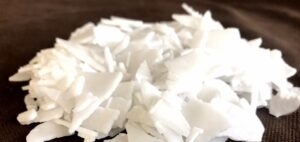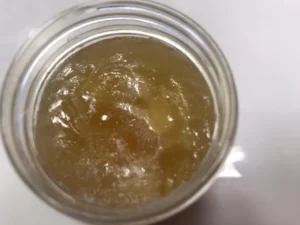What is Microcrystalline Wax
Microcrystalline wax is a distinct type of wax derived mainly from the refining of crude petroleum. Unlike its counterpart, paraffin wax, which is made up of mostly straight-chain hydrocarbons, microcrystalline wax contains a higher proportion of branched hydrocarbons. This unique composition lends it properties like higher density and viscosity. In addition, it is known as an elastic and adhesive wax due to its structure. In addition, it is more flexible than paraffin wax, making it a versatile material in various industries.
Production Process
Microcrystalline wax is produced from the heavy distillates of lubricant oil production. You can see below how this wax type is produced:
Raw Material Sourcing
The journey of microcrystalline wax begins with crude petroleum, a complex mixture of hydrocarbons. This raw material is crucial as the specific characteristics of the crude oil significantly influence the properties of the final wax product.
Refining and Distillation
The crude petroleum is first refined, a process involving the separation of various components through distillation. During this stage, heavy distillates suitable for wax production are isolated. This distillation process is critical for determining the quality and characteristics of the wax.
De-Oiling Process
Following distillation, the heavy distillates undergo a de-oiling process. This step is essential for removing excess oils and impurities, which helps in enhancing the wax’s purity and consistency.
Further Refinement
Depending on the desired end-use, the wax may undergo additional processing. This can include filtration to remove color and odor, especially when the wax is intended for applications where these attributes are crucial, like in cosmetics or food packaging.
Industrial Applications of Microcrystalline Wax
Microcrystalline wax is used in many different industries. You will be surprised when you learn how this material is at the center of our daily lives.
Industrial and Manufacturing Uses
Adhesives and Sealants: Microcrystalline wax is widely used in the production of adhesives due to its tackiness and binding properties.
Rubber and Tires: In the rubber industry, it helps in molding and shaping processes, enhancing the durability and flexibility of the final products.
Cosmetics and Personal Care
Skincare and Makeup: Microcrystalline wax in cosmetics improves texture, provides structure to products like lipsticks, and enhances the spreadability of creams and lotions.
Hair Care Products: It’s used in hair styling products for its ability to hold style without stiffness.
Food and Packaging
Food Grade Waxes: Safe for food contact, it is used in coating fruits and in packaging materials to preserve freshness and prevent moisture loss.
Wax-Coated Paper and Boards: Ideal for packaging due to its water-resistant properties.
Arts and Crafts
Sculpting and Jewelry Making: The wax’s pliability makes it suitable for sculpting, allowing artists to create detailed models and molds.
Candle Making: It’s preferred in candle making for its higher melting point, which results in slower-burning and longer-lasting candles.
Sports Equipment
Winter Sports: Used in the maintenance of snowboards and skis to reduce friction, enhancing performance.
Hockey Sticks: Applied to hockey sticks to improve grip and control.
Automotive Industry
Protective Coatings: It is used in the automotive industry for protective coatings, offering durability and resistance against environmental elements.


